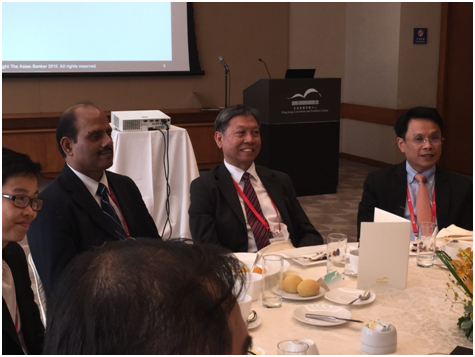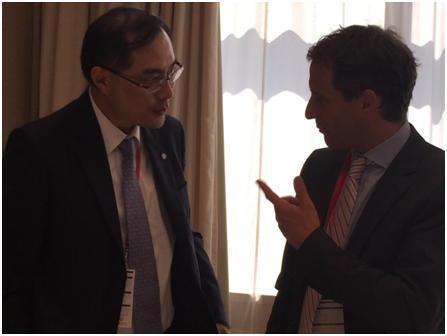Optimising opportunities for growth in the changing global clearing landscape
The Asian Banker held a high-level dialogue with heads of transaction banking and their senior management equivalents on 16th April 2015 in conjunction with the Asian Banker Summit 2015
June 10, 2015 | ResearchThe Asian Banker – Private Luncheon Dialogue
Proceedings report on dialogue on ‘Optimising opportunities for growth in the changing global clearing landscape.’
- Introduction
- The Asian Banker held a high-level dialogue with heads of transaction banking and their senior management equivalents on 16th April 2015 in conjunction with the Asian Banker Summit 2015.
- The following report summarises the central points presented by the key speakers of the session, including main issues discussed, as well as the Question and Answer session that followed.
- In Attendance
Key participants in this dialogue were:
- Mr Songpol Chevapanyaroj, SEVP & MD, Global Transaction Banking Group, Krung Thai Bank
- Mr Yumesaku Ishigaki, Global Head of Transaction Banking, BTMU
- Mr Swaminathan Janakiraman, Deputy GM, Global Trade Services, State Bank of India
- Mr Derek Gibson, General Manager, Banco Santander, HK Branch
- Ms Amy Chan, Executive Vice President, Head of Financial Institutions Group, Hang Seng Bank
- Mr Samuel So, Deputy General Manager, Head of Cash Management, Bank of China (Hong Kong)
- Mr Thanatphong Pratheepthaweephon, Correspondent Banking Department, Bangkok Bank
- Ms Soh Fern Boey, Managing Director, Head of Global Transaction Services, Institutional Banking Group, DBS Bank(Hong Kong) Limited
- Mr Marcus Sehr,Global Head of Institutional Cash and Regional Head of Institutional Cash and Securities Services, EMEA, Deutsche Bank
- Mr Christopher Lui,Head of Institutional Cash and Securities Services, Greater China, Deutsche Bank
- Mr Foo Boon Ping, Managing Editor, The Asian Banker
- Presentation
The Asian Banker presentation notes
- Integration of products, services and platforms remains key focus
Shifts in Key Trends in Asia, identified in over 100 submissions from 2012 to 2014 - Integration of products and channels
- Risk & Compliance
- Supply Chain Financing
- Rmb Trade Products and Services
- End-to-end automation, higher STP, ERP integration
- More emphasis on liquidity and working capital management
- Electronic LCs and BPOs
- Greater focus on regionalisation and integration of product, infrastructure and platforms
Achieving Product, Service and Infrastructure integration - Platform – From “Separate platforms for client interaction in cash and trade” To “Single global platform covering all countries, with multilingual, multichannel, multibank reporting and multicurrency capabilities, integrated among cash, trade and treasury”
- Relationship – From “Trade finance and cash management in silo departments. Not able to provide a “one-stop” banking” To “customised and consultative approach, collaborate closely with client coverage, products and FI functions to provide integrated product service”
- Products and Services – From “Fragmented product and service offerings on cash, trade, payments and treasury. Products offered are either trade or cash centric” To “Supply chain financing, embedded FX and Treasury products to become significant revenue generator for banks, as they take a more holistic view of working capital requirements.”
- Infrastructure Capabilities – From “Implementing process centralization, risk mitigation measures, adding visibility and controls” To “Centralised and real-time transaction processing based on open international industry standards.”
- Key discussion notes
- Payment Innovations (Real time payments, Asian hours netting and prioritization)
- Basel III (Intraday Liquidity Reporting, LCR)
- Regulatory Landscape (AML Directive, FATF, KYC Registry)
- Detailed discussion notes
- The importance of and evolving landscape of global clearing
- The Asian Banker introduced a new Best Global Clearing Bank in Asia Pacific award as part of its Transaction Banking awards programme to reflect the growing demand and development of multi-currency as well as cross-currency clearing capability of banks in the region.
- Deutsche Bank, winner of the inaugural Best Global Clearing Bank in 2015, was invited to co-host the luncheon to share its best practices and discuss topics of concerns with a select group of Asian banks.
- The bank was able to grow its clearing business in 2014 despite a challenging international operating environment and gained market share by leveraging on its consolidated cross-business partnerships.
- It is the leading provider of global cross-currency clearing service. It is ranked as one of the top 3 providers of EUR and USD clearing, and is currently ranked No.1 in EUR clearing, with market share of 50%
- It launched a global campaign to accelerate the growth of its cash management, trade finance business by leveraging FX cross-selling opportunities, this led to a 7% growth in new mandates. The increased cross-selling between cash management and FX, focusing on promoting higher margins FX deals was highly successful, with a 40% increase in FX revenue.
- Deutsche Bank reiterated its commitment to support the business growth and development of the FI community and partners.
- Payment Innovations (Real time payments, Asian hours netting and prioritization)
- Investment in corporate payment infrastructure and innovation is often over-shadowed by investment in retail payment initiatives.
- It is a challenge to get board approval for corporate payments system in relation to retail payments. Margins for corporate payments are perceived to be smaller than for retail payment, despite volume being much higher.
- Disruption in the payment area, for example in China it has become common to use Ali pay to pay for taxi fare because of the incentives given to both passengers as well as drivers.Fierce competition perceived in the payment space.
- Operational risks associated with payments, such as cyber fraud and cyber attack. While there is increasing pressure on automation, enhancing STP rate, but at the same time, there is greater need for cyber security.
- In some markets, such as the US, there is a 30-minute “remorse” period. Remittances will be kept in the account until the time lapses.
- In some other markets, such as Thailand and Singapore, some banks allow their customers to cancel or amend their payments by 5pm. This will cause delay in processing that will affect customers.
- Banks can’t do everything, they have to be selective in what exception they allow their customers. There may be special reason for particular customer who request it but that should not be something general.
- In India, changes are coming. The Reserve Bank of India introduced differentiated licensing for the banking industry in the form of specialised payment banks, which will not handle deposits or lending, but will focus only on payments.
- The RBI has been pushing for the consolidation of the bank industry as well as differentiated licensing.
- Banks have to tie up with a telecom company to bid for the license. So far,about 8 to 9 banks have indicated their interest to bid.
- There will be tie-ups with telecoms companies and it will be focused on mobile, hand-held devices. There will a number of agent outlets but otherwise not a lot of physical set-ups
- And in some markets, where there is a lot of micro payments, there is greater financial inclusion. India is one, in the Philippines and Indonesia too. Banks are working with agents, there is no need to have a branch network, it is done through the mobile phone and telecoms companies. That is where they are taking the business away from the traditional banks.
- The impact of non-bank players on payments
- Banks have a lot more responsibility to the customers and is subject to stringent regulations as compared to the non-banks. In India, the movement towards licensing specialized payment banks is a good example that the central bank is trying to level the playing field for everyone, “let’s do it together”.
- However, the capital requirement will be a lot less, the cost efficient of the payment value chain is still huge. Banks probably underestimate the impact of the non-banks’ business because they probably still cannot effectively respond to the challenges such as real-time payments or any mode of payments that the non-banks are answering now, that’s why they are getting more and more popular.
- It is not a level-playing field, and non-banks have an advantage in that they are not subject to the same level of regulation such as AML and KYC, which is very strict, if you have a subsidiary in the United States.
- Impact of correspondent banks on operational risks and payment fraud
- If a FI outsources the payment services to an international bank, then it makes some mistake on anti-money laundering compliance, what’s going to happen? The FI customer or the international bank could be punished because this bank hasn’t really processed or performed the function properly. What’s going to happen?
- Right now, there is no mutual KYC theme, policies or measures to help in preventing money laundering. The interesting thing about money laundering is that in most cases they are only identified after the fact.
- Banks have to make sure that they are banking with institution who are asking a lot of the right questions around their transactions and counter parties. All banks must be asking the same questions and doing their best in order to make sure that they are operating in a safe environment, and your provider is still there tomorrow and the day after tomorrow, so that you can continue banking with us.
- It boils down to a culture of compliance and the rigor of internal processes and also the focus on being compliant and on building a brand name that you want to protect.
- Payment fraud is an area of increasing focus and concerns to banks. Where there is a greater need for solution, whether be it through technology system and transaction analysis and monitoring and the need to continually engage with customers to understand their requirements and behaviors in order safeguard their transactions.
- What impact will the RMB have on dollar and EURO-based banks such as Deutsche Bank?
- Deutsche Bank will continue to invest in building its Rmb capability as it believes that the end state of the Rmb is that it will become an international currency.
- There are many offshore Rmb-clearing hubs now in Hong Kong, Singapore, Luxembourg, Paris, London, New York, Frankfurt, etc, these reflect the efforts of the Chinese authorities to promote and market the use of the Rmb, which they are doing very well.
- For a local bank or a regional bank, it does not make sense to connect to many hubs. The Rmb will be more accessible in the future with CIPS which is a step in the right direction.
- It will shift the case for US Dollar and Euro transactions. But nothing will change in 2016 or 2017, it will probably happen in 2020, 2025, when the Rmb has caught up with the Euro and the US Dollar.
- Full convertibility is just a matter of time. The pace of internationalization in just the past few years is incredible.
- The Hong Kong-Shanghai Stock Connect is something that was once not thought possible. Yet it happened so fast. It only took 6 months from the announcement of the policy to the actual implementation and running of the stock connect.
- How does new LCR requirements impact the banks’ and customers’ liquidity?
- It is important not to think of liquidity in the operational span of 8 hours. Banks must see the wider picture, how much liquidity is needed to ensure settlement of all your requirements. Banks that can provide support in different time zones from the US to Europe.
- Many regulators have not yet put LCR reporting into the national regulatory requirement. It is still unclear as to what is required, whether on a 15 minute or a real-time instantaneous basis. Whether regulatory reporting is on a 3 month, 6 months, 12 months, or combined currency accruals.
- Many open questions and industry consultation is required. There is a Basel working group to answer these questions.
- Getting together as an industry, talking together as an industry, and probably also coming with some suggestions to the regulators is not a bad thing, because no one knows payments and transaction banking better than the people in the industry.
- Talking to the regulators helps. They understand the situation and they developed solutions for the industry.
- Conclusion
- There is a lot of innovation as well as emerging threats in the payment space. It is a network based business that connect banks and their counterparties. As an industry, banks are integrally connected in the payment space.
- There are new non-bank, non-regulated players who are trying to disintermediate the payment and business flows.
- The response from the industry should not be an individual one but an industry response and banks have to come together with the regulators to come up with a solution that safeguard the interest of customers.
- The industry also has to come together to think of better ways of ensuring regulatory compliance.
- Photo Gallery




Categories:
Transaction BankingKeywords:Deutsche Bank, Transaction Banking

